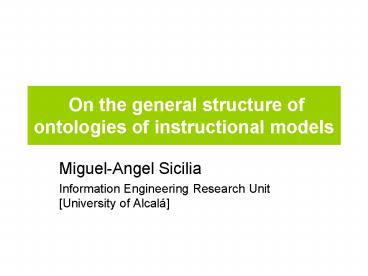On the general structure of ontologies of instructional models - PowerPoint PPT Presentation
1 / 10
Title:
On the general structure of ontologies of instructional models
Description:
On the general structure of ontologies of instructional models. Miguel-Angel Sicilia ... We assume a IMS LD ontology in OWL. lr:LearningObject(?lo) ... – PowerPoint PPT presentation
Number of Views:63
Avg rating:3.0/5.0
Title: On the general structure of ontologies of instructional models
1
On the general structure of ontologies of
instructional models
- Miguel-Angel Sicilia
- Information Engineering Research Unit University
of Alcalá
2
Motivation
- The status of pedagogical metadata
- IEEE LOM InteractivityType/level, etc.
- IMS LD Represents the structure, not the
pedagogical rationale behind - Some classifications exist, e.g. Conole.
- What about intructional design?
- ID techniques constraint the universe of possible
LD (combinations of resources/activities)
3
Instructional models
- Instructional models
- practice-oriented theories offering explicit
guidance on how to help people learn that offer
situation-specific methods, that in turn are
described in terms of components, and that are
know to be effective for learning under some
conditions (to some extent). - Methods can be made operational
- Result
- Learning resources, e.g. an IMS LD.
4
Not talking of Process models
- E.g. ADDIE
5
Design constraints
- A concrete learning design LD expressed in a
digital educational description language is
provisionally conformant to the IDModel A if
there exist a legal interpretation LI of A in
terms of the description language and LD fulfills
all the constraints contained in LI.
6
Ontologies and rules
- TheoryOne
- give abundant examples of the concepts treated
- We assume a IMS LD ontology in OWL.
lrLearningObject(?lo) ? lrhasPart(?lo, ?lo2)
? lrhasPart(?lo, ?lo3) ? lrExerciseLO(?lo2) ?
lrExerciseLO(?lo3) ? hasAbundantExamples(?lo
, true) lrLearningObject(?lo1) ?
lrhasPart(?lo1, ?lo2) ? lrhasPart(?lo2, ?lo3)
? lrhasPart(?lo1, ?lo3)
7
Requirements
- State the objectives.
- State the kinds of learning resources.
- State sequences and relations between them.
- these can be found in IEEE LOM to some extent.
- Use your favorite DLrules language.
8
Usage
- Practical application
- Search give me LD that complies with inst.
theory X.
9
Elaboration theory
- Teach broader, more inclusive concepts before
narrower, more detailed concepts that elaborate
upon them
10
Conclusions
- (some)Intructional methods can be (partially)
made operational in term of learning resources. - Some are still too abstract (this can be a
criteria for validness) - (different) sets of rules can be used to check
them as an aid in the instructional design
process. - This is largely unexplored.
- This has practical applications to design tools
and for search!.































